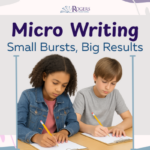Hello, dedicated educators! Today, we’ll walk through a practical lesson on summarizing using Langston Hughes’ classic short story, “Thank You, Ma’am.” Summarizing is an essential skill that helps students distill a text to its core components, promoting comprehension and retention.
Why Summarizing Matters
Summarizing requires readers to engage deeply with the text, evaluate information, and synthesize it into a concise format. This skill enhances comprehension and is correlated with higher standardized test scores (Reed & Vaughn, 2010). Additionally, educational standards, such as the Common Core, emphasize the importance of summarizing at various grade levels.
The Six-Step Summarization Process
- Delete Trivial Information
- Delete Redundant Information
- Substitute Superordinate Terms for Lists
- Substitute Superordinate Terms for Events
- Select a Topic Sentence
- Invent a Topic Sentence (if none exists)
Lesson Plan: Summarizing “Thank You, Ma’am”
Step 1: Introduction
Start by explaining the importance of summarizing to your students.
“Class, summarizing helps us understand and remember what we read. It’s a skill you’ll use throughout your education and beyond. Today, we’ll practice summarizing with Langston Hughes’ story ‘Thank You, Ma’am.'”
Step 2: Read the Text
Read “Thank You, Ma’am” together as a class. Ensure students understand the story before diving into summarization.
Step 3: Model the Summarization Process
Use the six-step process to model summarizing the story’s first paragraph:
- Delete Trivial Information: Identify and remove unnecessary details.
- Delete Redundant Information: Eliminate repetitive information.
- Substitute Superordinate Terms for Lists and Events: Group related ideas under broader terms.
- Select a Topic Sentence: Identify the main idea of the paragraph.
- Invent a Topic Sentence: Create a main idea sentence if none exists.
For example:
“She was a large woman with a large purse that had everything in it but hammer and nails. It had a long strap, and she carried it slung across her shoulder. It was about eleven o’clock at night, and she was walking alone, when a boy ran up behind her and tried to snatch her purse. The strap broke with the single tug the boy gave it from behind. But the boy’s weight and the weight of the purse combined caused him to lose his balance so, instead of taking off full blast as he had hoped, the boy fell on his back on the sidewalk, and his legs flew up. The large woman simply turned around and kicked him right square in his blue-jeaned sitter. Then she reached down, picked the boy up by his shirt front, and shook him until his teeth rattled.”
Summary:
A boy tries to snatch a woman’s purse at night but fails and is caught by the woman.
Step 4: Guided Practice
Guide students through the summarization of the next few paragraphs. Ask prompting questions to help them identify key information and eliminate trivial details.
“What’s the main idea of this paragraph? Which details are essential, and which can we remove?”
Step 5: Independent Practice
Have students work in pairs to summarize the following paragraphs, then share their summaries with the class. Circulate to provide support and feedback.
Step 6: Discuss and Reflect
Discuss as a class how summarizing helps in understanding the story. Reflect on the process and the students’ experiences.
“How did summarizing help you understand ‘Thank You, Ma’am’ better? What challenges did you face?”
Sample Summary of “Thank You, Ma’am”
To give students a clear example, here’s a full summary of the story:
Late at night, a boy named Roger tries to steal Mrs. Luella Bates Washington Jones’ purse but fails. Instead of taking him to the police, Mrs. Jones takes him to her home, washes his face, feeds him, and gives him money for the blue suede shoes he wanted. She teaches him a lesson about kindness and trust before letting him go, leaving Roger grateful and changed.
Closing Thoughts
Summarizing is a powerful tool that enhances students’ comprehension and retention. By breaking down “Thank You, Ma’am” through the six-step process, students can learn to identify key information and express it concisely.


